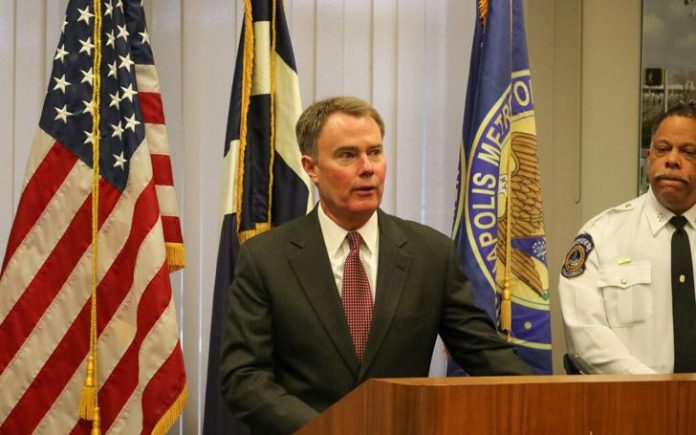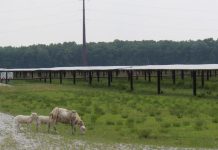Indiana Cities Experiment With Gunshot Detection Tools
 Indianapolis Mayor Joe Hogsett delivers a speech to officers in the IMPD chief’s conference room. He released a violence prevention plan last year to address the city’s rising homicide rate.
Indianapolis Mayor Joe Hogsett delivers a speech to officers in the IMPD chief’s conference room. He released a violence prevention plan last year to address the city’s rising homicide rate.INDIANAPOLIS—When there’s a mass shooting, everyone hears about it. And much to the dismay of most Americans, there’s been no shortage of gun violence lately. By mid-May, the United States had already experienced 198 mass shootings.
A racially motivated shooter in Buffalo, New York, who left 10 people dead on May 14 was preceded by a series of non-lethal shootings in Milwaukee the day prior and followed by gun violence at a church in Laguna Woods, California, and an open-air market in Houston the next day.
Police typically have to guess the places from which gunshots emanate based on opinions from neighbors and people who overhear the noise.
However, cities across the U.S. are implementing gunshot detection systems, like ShotSpotter, to pinpoint the source of gunfire. They’re experiencing varying levels of success, and Indiana has followed the trend.
How does ShotSpotter work?
ShotSpotter identifies crime hotspots by using crime data gathered by police departments while also drawing on location-specific information like population density, weather, and proximity to liquor stores and bars. It identifies high-crime zones as “risk areas†for gunfire.
ShotSpotter installs 20 to 25 microphones per square mile in cities that pay for its service.
Each time a banging noise that breaches 120 decibels occurs, a ShotSpotter employee in a dispatch center listens to the sound to determine if it’s a gunshot. If confirmed, ShotSpotter alerts the local police department within 30 seconds of the gunfire.
This allows police to arrive at crime scenes faster than before. On average, it takes two and a half minutes for an officer to arrive to a scene after an independent citizen reports gunfire by calling 911.
And a quicker response time can make a difference because only 39% of shootings last more than five minutes. Gunfire detection technology also means that police can respond to gunfire that they wouldn’t have known about otherwise.
ShotSpotter data parallels that of other resources in affirming that gun violence is on the rise.
The number of gunshots detected by ShotSpotter was higher in 2020 and 2021 than in 2019.
Both years experienced instances where the number of gunshots exceeded six gunshots per square mile per week.
The busiest time of day for gunfire is 10 to 11 p.m.
South Bend
The South Bend Police Department tested its ShotSpotter Connect system last year, firing shots to gauge its accuracy.
In 2016, South Bend paid $165,000 to maintain the system, and the city has since been working out the kinks in the software’s utility.
Indianapolis

Indiana’s largest city is still working to select a business or vendor that it will pay to implement gun detection services.
Mayor Joe Hogsett released a violence prevention plan in early 2021 to respond to the rising number of gun-related deaths.
The American Rescue Plan Act, intended to protect vulnerable workers economically and physically, gave $150 million to acquire additional police officers while also granting $9 million in modern technology for license plate readers, public safety cameras and a gunshot detection pilot program.
The city plans to test a gunshot detection service during a three-month pilot period. The service should ideally be able to determine the origin of certain types of gunshots with at least 90% accuracy, police say.
The testing location will be a five-square-mile patch of land on the city’s east side.
The planned pilot program comes after Indy experienced an all-time high of 245 homicides in 2020, only to be trumped by 271 in 2021.
ShotSpotter criticism
Cincinnati started using ShotSpotter technology nearly five years ago, mirrored by other cities including Wilmington, North Carolina; Savannah, Georgia; and Worcester, Massachusetts.
But activists in some of these places, especially in Worcester, say the software unfairly targets minority communities. They insist that the crime data on which ShotSpotter relies is based on decades of racial profiling.
They also fear that some officers could be justified in their targeting of minority communities if they can simply rely on a computer to instruct their decisions.
Several organizations, including the American Civil Liberties Union, The Associated Press, and VICE news are also questioning the integrity of gunshot detection systems.
The ACLU objects to the fact that the systems send police into minority areas often expecting dangerous interactions. During these police runs, the ACLU says there is a potential for other arrests that have nothing to do with gunfire.
Chicago’s inspector general released a report that supports this claim. The report confirms that false leads from ShotSpotter result in more stops and pat downs in high-crime zones.





